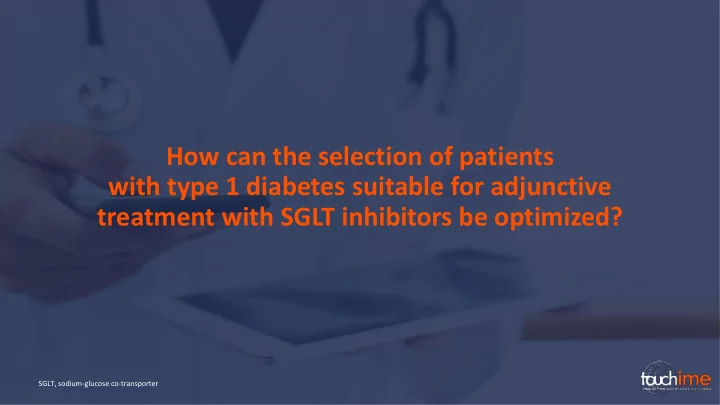

How can the selection of patients with type 1 diabetes suitable for adjunctive treatment with SGLT inhibitors be optimized? SGLT, sodium-glucose co-transporter
Disclaimer Unapproved products or unapproved uses of approved products may be discussed by the faculty; these situations may reflect the approval status in one or more jurisdictions. The presenting faculty have been advised by touchIME to ensure that they disclose any such references made to unlabelled or unapproved use. No endorsement by touchIME of any unapproved products or unapproved uses is either made or implied by mention of these products or uses in touchIME activities. touchIME accepts no responsibility for errors or omissions.
What is the rationale for using SGLT inhibitors as an adjunct to insulin therapy in patients with type 1 diabetes? Dr Manon Khazrai Dietitian and Counsellor Endocrinology and Diabetes Clinic Campus Bio-Medico University, Rome, Italy SGLT, sodium-glucose co-transporter
Many people with type 1 diabetes do not achieve good glycaemic control 100 Percentage of people with HbA 1c of • A comparison of glycaemic control among children* 58 mmol/mol (<7.5%) and/or adults with type 1 diabetes using data from regional or national registries showed that many people do not achieve good glycaemic control 16 – 46% 9 – 50% 21 – 54% • Data were obtained for 324,501 children and/or 50 adults from:** Australia, Austria, Denmark, France, Germany, Greece, Ireland, Italy, Latvia, The Netherlands, New Zealand, Norway, Sweden, UK, Ukraine, USA 0 Chronic exposure to hyperglycaemia in type 1 diabetes <15 15 – 24 ≥25 carries an increased risk of microvascular and Years Years Years macrovascular disease 2 (n=44,058) (n=50,766) (n=229,677) *SGLT inhibitors are not approved for use in children; **Some data are national and some are regional; HbA 1c , glycated haemoglobin 1. McKnight JA, et al. Diabet Med. 2015;32:1036 – 1050; 2. McCrimmon RJ, et al. Diabetologia 2018;61:2126 – 2133.
Barriers to reaching glycaemic targets Other factors may include: • Limitations of current insulin delivery systems Fear of hypoglycaemia 1 (peripheral drug delivery and lack of feedback inhibition) 2 • Age at onset of diabetes 3 • Genetic background 4 • HbA 1c values before the intervention and C-peptide levels 3 Fear of weight gain 1 • Diabetes-related knowledge 3 • Economic status 4 • Psychological factors such as lack of motivation, emotional distress, depression and eating disorders 4 • Lifestyle factors such as smoking 3 HbA 1c , glycated haemoglobin 1. Danne T, et al. Diabetes Care 2019;42:1147 – 1154; 2. McCrimmon RJ, et al. Diabetologia 2018;61(10):2126 – 2133; 3. Bott U, et al. Diabet Med . 1994;11:362 – 371; 4. Devries JH, et al. Diabet Med . 2004;21(12):1263 – 1268.
The goals of adjunct therapy in type 1 diabetes Reduction of HbA 1c without increasing hypoglycaemia and weight gain 1 Reduction of glucose variability 2 Reduction of complications through improved glycaemic control 3,4 ! Adjunct therapy does not replace insulin 1,3,4 HbA 1c , glycated haemoglobin 1. Danne T, et al. Diabetes Care 2019;42:1147 – 1154; 2. Pettus JH, et al. Diabetes Technol Ther. 2019;21:336 – 343; 3. Tosur M, et al. Curr Diab Rep. 2018;18:79; 4. DCCT/EDIC Writing Team JAMA. 2002;287:2563 – 2569.
SGLT inhibitors: an insulin-independent approach that removes excess glucose by reducing the renal threshold 1,2 G G G G G G G G SGLT2 G SGLT2 G G G G G G Blood Urine Blood Urine SGLT2 mediates the reabsorption of ~90% of SGLT2 inhibitors block SGLT2, thereby filtered glucose in the S1 segment of the renal increasing the glucose excreted in the urine and proximal tubule 3 decreasing plasma glucose 3 Dual SGLT1 and 2 inhibitors also reduce glucose reabsorption in the gastrointestinal tract. 4 SGLT, sodium-glucose co-transporter 1. Marsenic O. Am J Kidney Dis. 2009;53:875 – 885; 2. Mudaliar S, et al. Diabetes Care 2016;39:1115 – 1122; 3. Gomez-Peralta F, et al. Diabetes Ther. 2017;8:953 – 962; 4. Sands AT, et al. Diabetes Care 2015;38:1181 – 1188.
SGLT inhibitors* can be prescribed to adults for the treatment of type 1 diabetes 1,2 Using approved doses Adjunct to In patients with per medication a insulin BMI ≥27 kg/m 2 *Only dapagliflozin (an SGLT2 inhibitor) and sotagliflozin (an SGLT1/2 inhibitor) are approved for use in patients with type 1 diabetes in Europe; a Please check respective doses before prescription; BMI, body mass index; SGLT, sodium-glucose co-transporter 1. EMA press release. Dapagliflozin. [Cited July 2019)] Available from: https://www.ema.europa.eu/en/news/first-oral-add-treatment-insulin-treatment-certain-patients-type-1- diabetes; 2. EMA press release. Sotagliflozin. [Cited July 2019] Available from: https://www.ema.europa.eu/en/news/new-add-treatment-insulin-treatment-certain-patients- type-1-diabetes.
Efficacy of SGLT inhibitor adjunct therapy in type 1 diabetes Meta-analysis of 14 randomised controlled trials of SGLT inhibitors as adjunct therapy in type 1 diabetes 1 0.40% a HbA 1c (9 studies) 1 CI: 0.35, 0.46 2.68 kg a Body weight (8 studies) 1 CI: 2.00, 3.36 6.00 IU a Total insulin dose (7 studies) 1 CI: 4.90, 7.10 1.45 mmol/L a Mean amplitude of glucose CI: 0.78, 2.12 excursion (MAGE) (3 studies) 1 (26.1 mg/dL) At the highest dose, ~3 hours/day Time in range 2 without an increase in time with hypoglycaemia a Weighted mean difference CI, confidence interval; HbA 1c , glycated haemoglobin; SGLT, sodium-glucose co-transporter 1. Yamada T, et al. Diabetes Obes Metab . 2018;20:1755 – 1761; 2. Danne T, et al. Diabetes Care 2019;42:1147 – 1154.
Recommend
More recommend